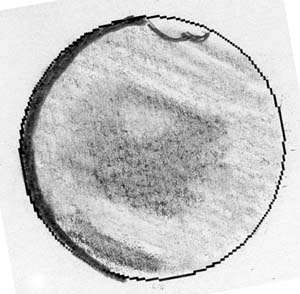
Sketched July 28, 2003 from my back deck 4:00 a.m. pacific DST (daylight savings time) or 11:00 UT. Mediocre observing night from 3:45 a.m. to 4:15 a.m. when the fog started rising.
| Date: 07/28/03 Lat 37.6N, Long 122W, elev. 200 feet | Sketch Time (UT): 11:00, (local time): 4:00 a.m. DST |
| Central Meridian: 47° | Filters: Orion Variable polarizing filter 1% - 40% transmission |
| Instrument: 4-inch (105mm) f/6 Astro-Physics Traveler Apo refractor. | Distance from earth 0.43 AU, 65m km, 40m miles |
| Magnification: (4mm) 376x (6mm) 252x (10mm) 151x Zeiss Abbe Orthos combined with a 2.4x AP Barcon Barlow | Transp. 2/6, Seeing 3/10, Antoniadi (I-V): III - IV |
| Apparent Size: 21.7" | Magnitude: -2.2 |
South Polar Cap notch and dark melt line continue to be prominent. Most other features blended into one large dark area, with a few subtle gradients in color. Mare Acidalium and Nilacus Lacus are the dark area near the bottom (north). Chryse is south of this. I did have some fun with an Orion Variable Polarizing Filter (1% to 40% transmission) that helped bring out the albedo features.
Mars, in this sketch is reversed N/S. South is shown at the top of the image. The south polar cap is the prominent feature, and shows a notch that was quite distinct to me. Terminator is where daylight ends and evening begins. The terminator is on the left and the planet is rotating left to right. In my sketches the planet rotates martian east (left) to west (right) to match most other images and sketches. Look for features rotating from left to right in the drawings from night to night.
Details about Mars: Diameter 21.7 arc seconds (Jupiter is about 30 -50 arc seconds in diameter depending on its distance from earth). Central Meridian 47 - the imaginary line passing through the planetary poles of rotation and bisecting the planetary disk, and is used to determine the longitude during an observing session.

White Oaks Home | Sketches Index | Mars 2003 Index | Back | Next